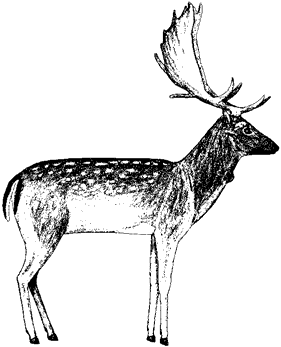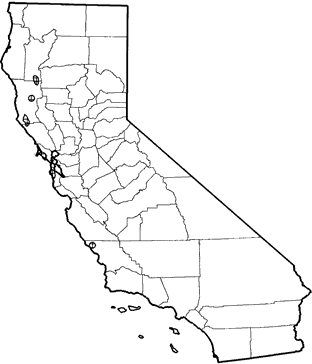
Fallow Deer
Distribution, Abundance, and Seasonality
Distribution limited to introduced populations, including those at Point Reyes National Seashore in Marin Co. (Wehausen and Elliott 1982), the Ridgewood Ranch north of Ukiah in Mendocino Co. (Jurek 1980) the vicinity of Pomponio Creek in western San Mateo Co., along the Eel River near Kekawaka Creek in southern Trinity Co., and on the Hearst Ranch in San Luis Obispo Co. The total population in the state appears to be about 300. Fallow deer in California are yearlong residents of perennial and annual grasslands, coastal scrub, closed-cone pine-cypress, valley foothill hardwood, valley foothill hardwood-conifer, and valley foothill riparian habitats. Native to southern Europe, Asia Minor, and the Middle East (Chapman and Chapman 1975).

Range Map
Specific Habitat Requirements
Feeding: Fallow deer graze green parts of grasses and forbs, and occasionally browse. On Point Reyes Peninsula, grasses form the majority of the diet during the wet season; forbs predominate in the dry season (Elliott 1982).
Cover: Use shrubs and trees for concealment, fawning, shade, and shelter from inclement weather.
Reproduction: Rutting is concentrated in open grasslands. Fawning occurs in the cover of shrubs and forests (Wehausen 1973, Jurek 1977).
Water: Rarely observed to drink at Point Reyes National Seashore. Water must be available within fallow deer range during summer and fall in Mendocino Co. (Jurek 1977).
Pattern: Grasslands interspersed with shrublands or tree stands provide suitable habitats.
Species Life History
Activity Patterns: Active yearlong. Crepuscular, nocturnal, and some diurnal activity.
Seasonal Movements / Migration: Home ranges have seasonal shifts related to availability of forage, and cycles of sexual behavior (Wehausen 1973, Jurek 1977). No elevational migration observed.
Home Range: On Point Reyes Peninsula in 1972-73, does and fawns moved throughout a 39 km? (15 mi?) area during winter and early spring, and concentrated in 2 areas of 8.3 km? (3.2 mi?) and 4.7 km? (1.8 mi?) during late summer. Bucks concentrated in part of a 7.8 km? (3 mi?) area after the rut in November until antlers were regrown in August. During the rut, bucks spread out, and some moved throughout a 39 km? (15 mi?) area (Wehausen 1973). In Mendocino Co., fallow deer concentrated in 4 central areas, of about 1 km? (0.4 mi?), during winter. They spread throughout a 73 km? (28 mi?) area during summer when forage was scarcest (Jurek 1977).
Territory: Not territorial, except that dominant bucks will chase subordinate bucks from a rutting area where estrous females congregate (Espmark and Brunner 1974).
Reproduction: Polygynous mating occurs in mid-October, with consequent fawning in June. Does have single fawns, and breed first at 16 mo (Chapman and Chapman 1975). On Point Reyes Peninsula, potential annual rate of increase of doe population was more than 11% (Wehausen and Elliott 1982).
Niche: Mountain lions, bobcats, and coyotes may prey on a few individuals. On Point Reyes Peninsula, more than 50% of the fallow deer sampled had evidence of liver flukes, and 7% had lungworms (Brunetti 1976). In California, often sympatric with cattle, sheep, axis deer, or mule deer, and may share many of the same food species. May compete with cattle when available food is scarce. Conversely, cattle may improve habitat for fallow deer by grazing tall plants. On Point Reyes Peninsula, the presence of fallow deer does not alter the habitat preferences of the other sympatric ungulates, nor do fallow deer displace them from their preferred habitats (Elliott 1982). Referred to as Dama dama by some authors (Feldhamer et al. 1988).
Sources & References
California Department of Fish and Game, 1999.
California's Wildlife, Sacramento, CA.
Written by: H. W. Elliot III, reviewed by: M. White, edited by: G. Ahlborn
Brunetti, O. A. 1976. Summary of the findings of the deer study on the Point Reyes National Seashore and recommendations for management. Mimeo on file at Pt. Reyes Natl. Seashore, CA. 9pp. Chapman, D., and N. Chapman. 1975. Fallow deer: their history, distribution, and biology. T. Dalton, Ltd., London. 271pp. Elliott, H. W. III. 1982. Ecological relationships of cattle, axis deer, fallow deer, and black- tailed deer on Point Reyes Peninsula. Ph.D. Diss., Univ. Calif., Davis. 197pp. Espmark, Y., and W. Brunner. 1974. Observations on rutting behavior in fallow deer, Dama dama (Linne, 1758). Saeugetierkd. Mitt. 22:135-142. Feldhamer, G. A., K. C. Farris-Renner, and C. M. Barker. 1988. Dama dama. Mammal. Species No. 317. 8pp. Jurek, R. M. 1977. Status, ecology and behavior of a wild population of fallow deer in Mendocino Co., California, 1968-1970. M.S. Thesis, Humboldt State Univ., Arcata. 114pp. Jurek, R. M. 1980. Mendocino County fallow deer aerial survey, February 28, 1980. Calif. Dept. Fish and Game, Sacramento. 2pp. Riemann, H. P., R. Ruppanner, P. Willeberg, C. E. Franti, H. W. Elliott III, R. A. Fisher, O. A. Brunnetti, J. A. Aho, Jr., J. A. Howarth, and D. E. Behymer. 1979. Serologic profile of exotic deer at Point Reyes National Seashore. J. Amer. Vet. Med. Assoc. 175:911-913. Wehausen, J. D. 1973. Some aspects of the natural history and ecology of fallow deer on Point Reyes Peninsula. M.S. Thesis, Univ. Calif., Davis. 67pp. Wehausen, J. D., and H. W. Elliott III. 1982. Range relationships and demography of fallow and axis deer on Point Reyes National Seashore. Calif. Fish and Game. 68:132-145.
California Animal Facts | California's Wildlife